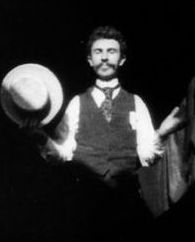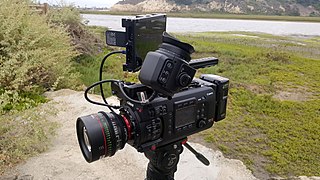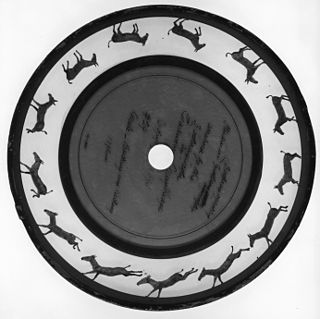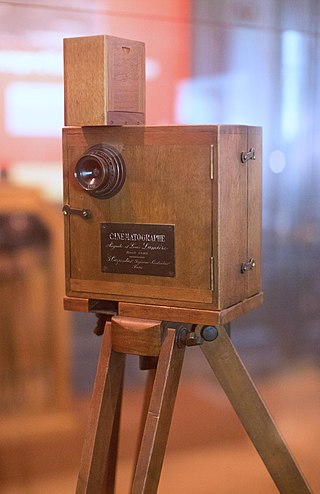| Years in film |
|---|
 |
| 19th century |
| 1870s |
This page indexes the individual year in film pages. Each year is annotated with its significant events.
| Years in film |
|---|
 |
| 19th century |
| 1870s |
This page indexes the individual year in film pages. Each year is annotated with its significant events.
Before Muybridge's 1878 work, photo sequences were not recorded in real-time because light-sensitive emulsions needed a long exposure time. The sequences were basically made as time-lapse recordings. It is possible that people at the time actually viewed such photographs come to life with a phénakisticope or zoetrope (this certainly happened with Muybridge's work).

The Lumière brothers, Auguste Marie Louis Nicolas Lumière and Louis Jean Lumière, were French manufacturers of photography equipment, best known for their Cinématographe motion picture system and the short films they produced between 1895 and 1905, which places them among the earliest filmmakers.
The history of film chronicles the development of a visual art form created using film technologies that began in the late 19th century.

William Kennedy Laurie Dickson was a British inventor who devised an early motion picture camera under the employment of Thomas Edison.

Eadweard Muybridge was an English photographer known for his pioneering work in photographic studies of motion, and early work in motion-picture projection.

Cinematography is the art of motion picture photography.
The following is an overview of the events of 1895 in film, including a list of films released and notable births.

A movie camera is a type of photographic camera that rapidly takes a sequence of photographs, either onto film stock or an image sensor, in order to produce a moving image to display on a screen. In contrast to the still camera, which captures a single image at a time, the movie camera takes a series of images by way of an intermittent mechanism or by electronic means; each image is a frame of film or video. The frames are projected through a movie projector or a video projector at a specific frame rate to show the moving picture. When projected at a high enough frame rate, the persistence of vision allows the eyes and brain of the viewer to merge the separate frames into a continuous moving picture.

Steadicam is a brand of camera stabilizer mounts for motion picture cameras invented by Garrett Brown and introduced in 1975 by Cinema Products Corporation. The Steadicam brand was acquired by Tiffen in 2000. It was designed to isolate the camera from the camera operator's movement, keeping the camera motion separate and controllable by a skilled operator.

The Kinetoscope is an early motion picture exhibition device, designed for films to be viewed by one person at a time through a peephole viewer window. The Kinetoscope was not a movie projector, but it introduced the basic approach that would become the standard for all cinematic projection before the advent of video: it created the illusion of movement by conveying a strip of perforated film bearing sequential images over a light source with a high-speed shutter. First described in conceptual terms by U.S. inventor Thomas Edison in 1888, it was largely developed by his employee William Kennedy Laurie Dickson between 1889 and 1892. Dickson and his team at the Edison lab in New Jersey also devised the Kinetograph, an innovative motion picture camera with rapid intermittent, or stop-and-go, film movement, to photograph movies for in-house experiments and, eventually, commercial Kinetoscope presentations.

Louis Aimé Augustin Le Prince was a French artist and the inventor of an early motion-picture camera, and director of Roundhay Garden Scene.

The zoopraxiscope is an early device for displaying moving images and is considered an important predecessor of the movie projector. It was conceived by photographic pioneer Eadweard Muybridge in 1879. Muybridge used the projector in his public lectures from 1880 to 1895. The projector used 16" glass disks onto which Muybridge had an unidentified artist paint the sequences as silhouettes. This technique eliminated the backgrounds and enabled the creation of fanciful combinations and additional imaginary elements. Only one disk used photographic images, of a horse skeleton posed in different positions. A later series of 12″ discs, made in 1892–1894, used outlines drawn by Erwin F. Faber that were printed onto the discs photographically, then colored by hand. These colored discs were probably never used in Muybridge's lectures. All images of the known 71 disks, including those of the photographic disk, were rendered in elongated form to compensate the distortion of the projection. The projector was related to other projecting phenakistiscopes and used some slotted metal shutter discs that were interchangeable for different picture disks or different effects on the screen. The machine was hand-cranked.

The Dickson Experimental Sound Film is a film made by William Dickson in late 1894 or early 1895. It is the first known film with live-recorded sound and appears to be the first motion picture made for the Kinetophone, the proto-sound-film system developed by Dickson and Thomas Edison. The film was produced at the "Black Maria", Edison's New Jersey film studio. There is no evidence that it was ever exhibited in its original format.

Chronophotography is a photographic technique from the Victorian era which captures a number of phases of movements. The best known chronophotography works were mostly intended for the scientific study of locomotion, to discover practical information for animal handlers and/or as reference material for artists. Although many results were not intended to be exhibited as moving pictures, there is much overlap with the more or less simultaneous quest to register and exhibit photographic motion pictures.

The Black Maria was Thomas Edison's film production studio in West Orange, New Jersey. It was the world's first film studio.

Actuality film is a non-fiction film genre that uses footage of real events, places, and things, in a similar way to documentary film. Unlike documentaries, actuality films are not structured into a larger narrative or coherent whole. In practice, actuality films preceded the emergence of the documentary. During the era of early cinema, actualities—usually lasting no more than a minute or two and usually assembled together into a program by an exhibitor—were just as popular and prominent as their fictional counterparts. The line between "fact" and "fiction" was not as prominent in early cinema as it would become once documentaries became the predominant non-fiction filmmaking form. Actuality as a film genre is related to still photography.
The decade of the 1890s in film involved some significant events.
Gordon Hendricks (1917–1980) was an American art and film historian.

The Horse in Motion is a series of cabinet cards by Eadweard Muybridge, including six cards that each show a sequential series of six to twelve "automatic electro-photographs" depicting the movement of a horse. Muybridge shot the photographs in June 1878. An additional card reprinted the single image of the horse "Occident" trotting at high speed, which had previously been published by Muybridge in 1877.

The history of film technology traces the development of techniques for the recording, construction and presentation of motion pictures. When the film medium came about in the 19th century, there already was a centuries old tradition of screening moving images through shadow play and the magic lantern that were very popular with audiences in many parts of the world. Especially the magic lantern influenced much of the projection technology, exhibition practices and cultural implementation of film. Between 1825 and 1840, the relevant technologies of stroboscopic animation, photography and stereoscopy were introduced. For much of the rest of the century, many engineers and inventors tried to combine all these new technologies and the much older technique of projection to create a complete illusion or a complete documentation of reality. Colour photography was usually included in these ambitions and the introduction of the phonograph in 1877 seemed to promise the addition of synchronized sound recordings. Between 1887 and 1894, the first successful short cinematographic presentations were established. The biggest popular breakthrough of the technology came in 1895 with the first projected movies that lasted longer than 10 seconds. During the first years after this breakthrough, most motion pictures lasted about 50 seconds, lacked synchronized sound and natural colour, and were mainly exhibited as novelty attractions. In the first decades of the 20th century, movies grew much longer and the medium quickly developed into one of the most important tools of communication and entertainment. The breakthrough of synchronized sound occurred at the end of the 1920s and that of full color motion picture film in the 1930s. By the start of the 21st century, physical film stock was being replaced with digital film technologies at both ends of the production chain by digital image sensors and projectors.